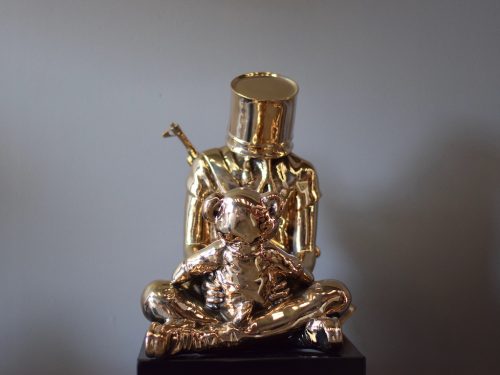

BIOGRAPHIE
” ist ” ANACHRONIC
Guillaume Cornelis van Beverloo, known as Corneille, was born to Dutch parents in 1922 in Liege, Belgium. He studied at the Amsterdam School of Fine Arts, and began his first solo exhibitions in 1946. The teaching that he receives doesn’t satisfy him. He considers it too academic and aspires to a freer artistic expression. This is why he decides at this time, to join the current of the surrealists. But the young artist doesn’t find himself there again. Driven by his irrepressible desire for freedom, Corneille decides to follow his own path. Accompanied by a circle of artists equally eager to confront their conceptual visions to the artistic dogmas of times, they give birth to the movement CoBrA. Karel Appel, Constant Nieuwenhuis, Asger Jorn, Dotremont and Corneille are among the initiators of this movement. Poets, painters and writers such as Jacques Doucet and Pierre Alechinsky soon joined this group.
CoBrA
In accordance with the eclecticism of the movement, Corneille experimented various artistic genres. His landscapes will notably evolve towards abstraction. After the dissolution of the group in 1951, Corneille returned to figuration and a kind childhood of art. He watches with interest the works of Paul Gauguin and his cohorts. During the 1960s, he travelled extensively. The luxuriant nature of the landscapes of Africa and South America captivated him. The expressionist and passionate vocabulary of the CoBrA period seems to be the best way to express his wonder. His palette is adorned with warm tones. The colors are vivid and shimmering. The drawing is surrounded by a thick black line. It divides, even orders, the free use of colors. Stylistically close to CoBrA but far from it iconographically speaking, Corneille aspires to dissociate himself from it. CoBrA’s painting, which favors serpentine lines, consists of a fantastic bestiary where the profusion of monsters creates a disturbing effect. There is nothing like this in the work of Corneille where the animal world seems to be seen through the eyes of a child.
The nomadic bird
As the years go by, his universe becomes more and more lyrical. The artist constructs a singular iconography, characteristic of his universe: the bird symbolizes him, the sun and the snake represent the feminine and masculine sexes. Corneille’s creations are pure and childlike. But we mustn’t give in to this apparent elementarity. The art of Corneille is not only a brilliant palette. On the contrary, tt is a lyrical universe, codified by an iconography of a rare singularity.
Corneille is buried on September 9, 2010 at the Auvers-sur-Oise cemetery, near the tomb of Vincent Van Gogh. His works will have marked the history of art. Notably exhibited at the Centre Georges Pompidou, the Museum of Modern Art of Paris and the COBRA museum, Some of his creations are also available for sale at the Mickaël Marciano Gallery.





